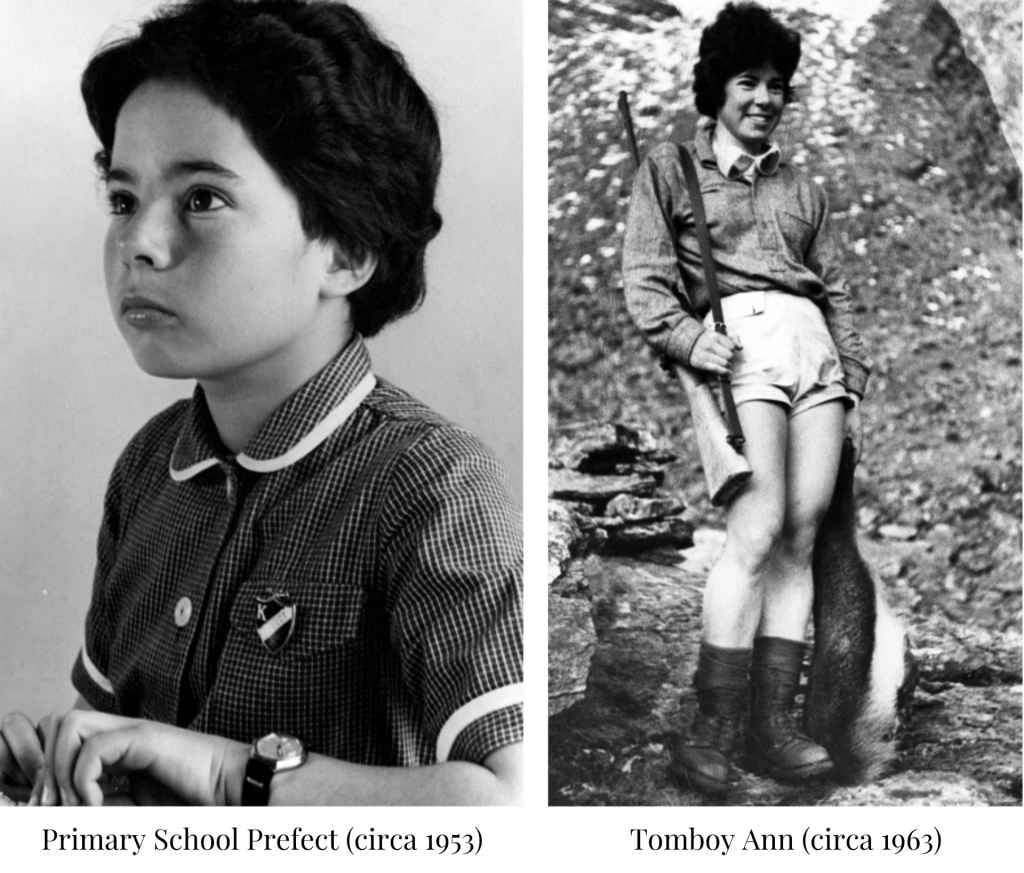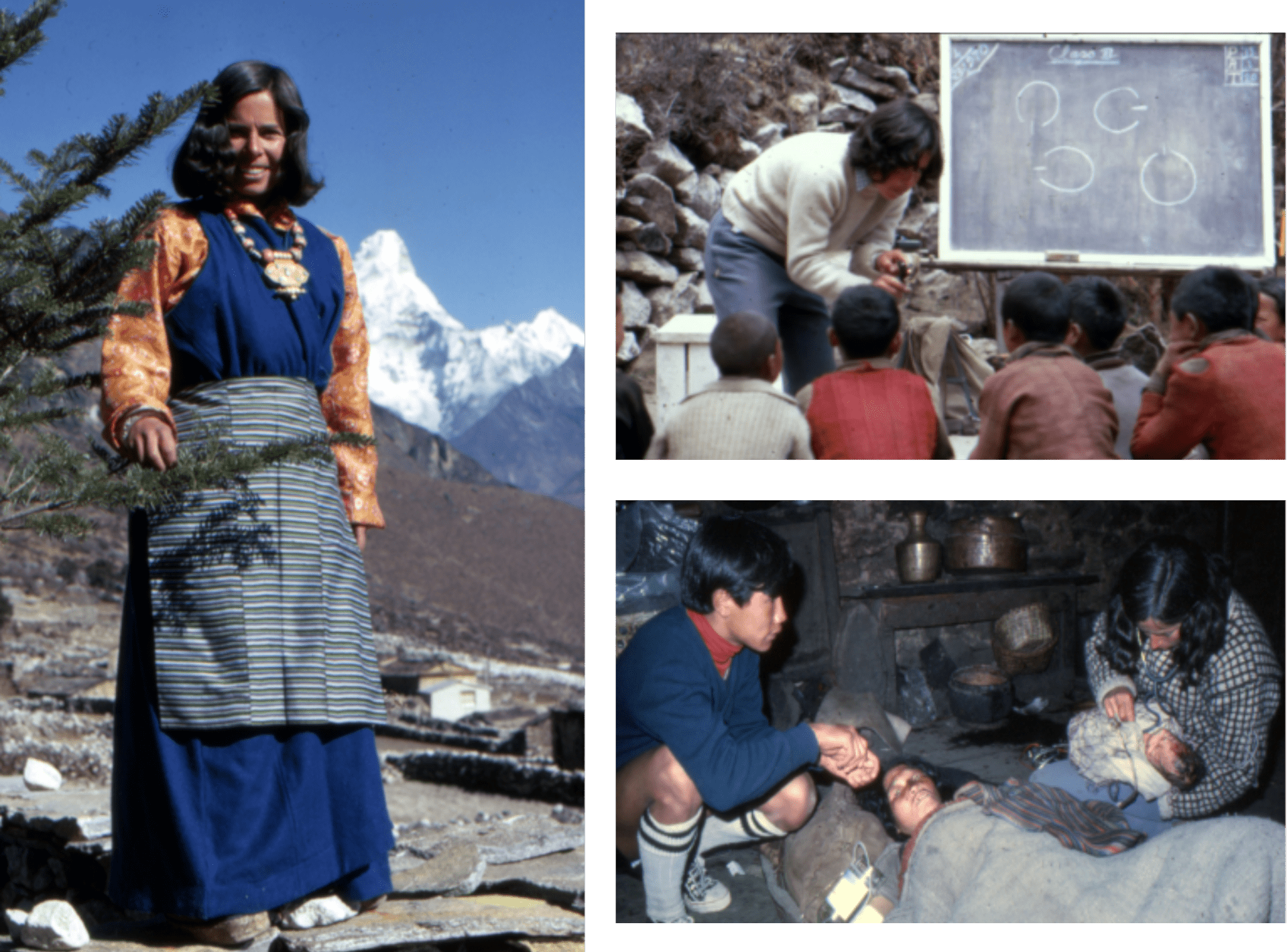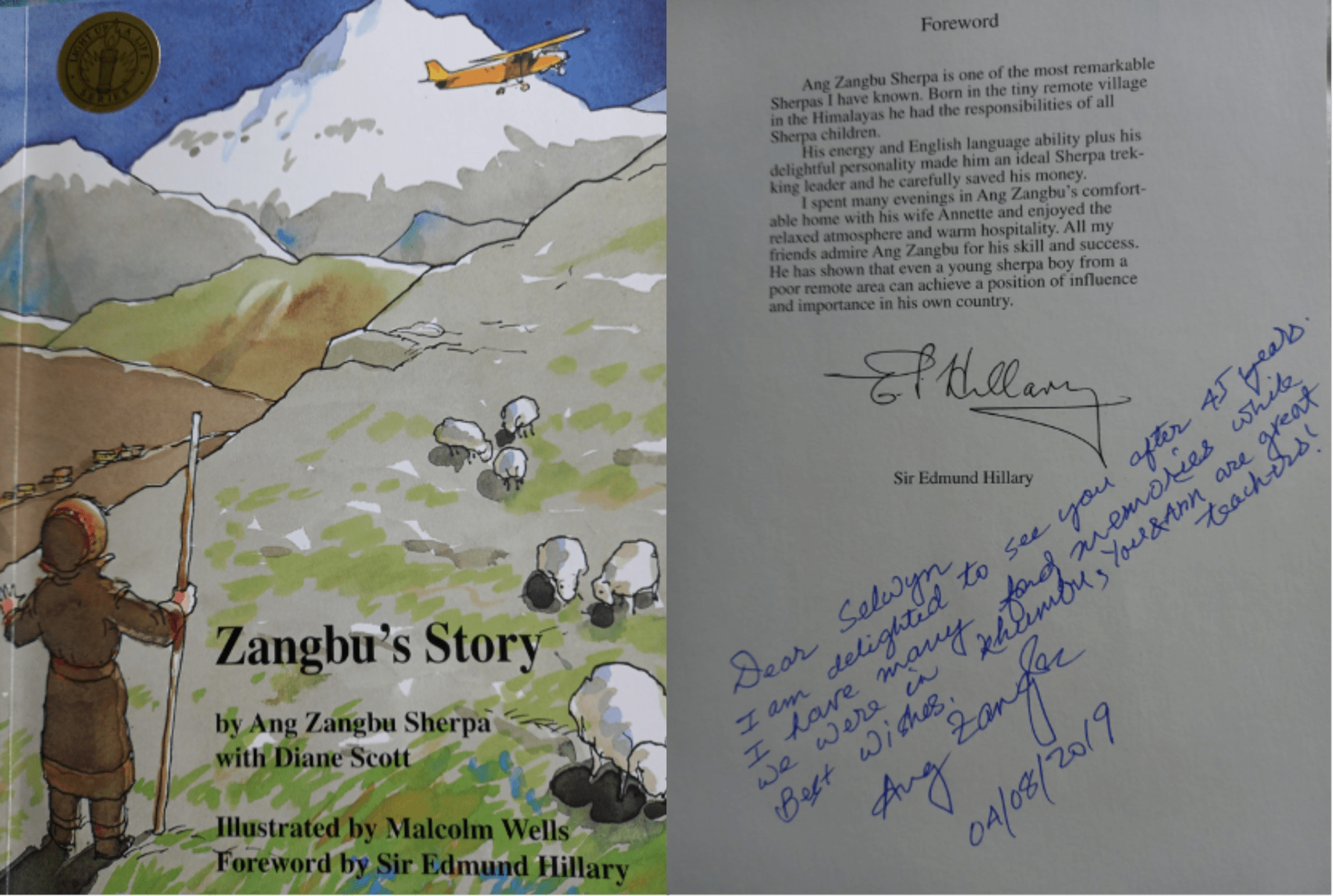
1967 Graduate
This biography is largely based on an oral interview with Ann’s husband, Dr Selwyn Lang, which was conducted by Prof Cindy Farquhar and Rennae Taylor. The biography was compiled by Rennae Taylor. Other sources are listed in the bibliography. All photos are courtesy of Ann’s family.
Contents
Family Background
Ann was born in Wellington of immigrant parents on 3 September 1943. Her father, Ernst Philipp, and his brother Fritz (later changed to Perry) were Jewish refugees from Nazi Germany who settled in England and the USA respectively, forsaking a well-to-do family tannery business in Cologne. The fate of those unable to leave was as expected, including the dismemberment of a WW1 Naval officer who dared to face the SS (Schutzstaffel) in the Jewish pogrom referred to as Kristallnacht, which occurred throughout Nazi Germany in November 1938. His naval uniform and iron cross did not save him. During the 1930s, Ernst subsequently qualified in medicine in 1936 (Bristol) and received his MD (Bristol) in 1938. His brother Perry became a professor at the University of Hawaii.
In 1936, Ernst was unexpectedly offered British nationality if he would go into private practice as a general practitioner in the new area of Filton where they were developing a huge aeroplane factory and consequently a large suburbia was springing up. He accepted immediately in order to have citizenship other than his refugee status as a German-born Jew. In Bristol, Ernst had met Eileen Brown, an almoner (predecessors of social workers) (1) of Anglo-Irish and Cuban descent, whose brother Norman, was a well-known social philosopher and author at University of California, Berkley, via Oxford. They were married in 1937. Almost immediately, severe asthma plagued Ernst in this new setting – he knew he needed to move to a warmer climate if he was to survive into late adulthood. In 1939, he and Eileen were given a warm reception by New Zealand House, and five weeks later, after signing up to immigrate, they were on the ship “Rimutaka” bound for New Zealand. World War II was declared enroute and while in Panama, within a single day, the ship was painted grey and the one machine gun on board was moved to the bow.
Ernst’s memoirs of his challenging life up to his arrival in New Zealand are published in the book “Growing in the Wilderness”. (1) Unfortunately, his marriage to Eileen came to an end around the time Ann started her university studies. He remarried in 1972. He practiced as a general practitioner in Wellington for the next forty years and died on 23 June 2000. (2) Ernst became the doctor for the German embassy in Wellington. Selwyn believes Ann had something to do with this appointment and remembers that she was very proud of her father for being able to forgive, if not forget, what German people had done to the Jews. Both he and Ann believed that individuals are increasingly responsible for their actions but not necessarily for their ancestors’ actions.
Her mother Eileen eventually became a researcher in education at the University of Otago and is remembered as an Irish born poet (especially Haikus) and short story writer. (3) Her son-in-law Selwyn remembers her writing a couple of plays that were broadcast in New Zealand: Rakiura, based on a Japanese woman’s stay in a cave at Doughboy Bay, Stewart Island and presented in Noh (classical dance-drama) play format, and one based on the Tangiwai disaster. She lived in Remuera in her retirement years and died 10 Sept 1986.
Childhood
Ann was the second of three siblings, all of whom were Otago graduates. Her elder brother, Robin, studied medicine and is now living in Bristol. Her younger sister, Elizabeth, lives in Auckland.

Ann attended the local primary school in Karori and later went to Marsden College where she became head prefect and captain of the hockey A team. She was something of a tomboy, insisting on being called Andy. Standing just under 4’11”, she was extraordinarily strong and was later dubbed “Iron-man Ann’’ by the New Zealand mountaineer, Graham Dingle.
 Otago University
Otago University
In 1960, Ann went straight from Marsden College to Otago University where she sat and passed Medical Intermediate in 1962. Initially, she stayed at Studholme College but later shared a student flat in Evans Street. It was during her second year of medical training that she met her future husband Selwyn Lang, a classmate who was not discouraged by her winning the women’s cross-country event just ahead of her sister. It was around this time she encountered Anthroposophy, which started her on her lifetime study of the works of Rudolf Steiner. (4)

In those days a bursary plus parental support were commonly subsidized by occasional student jobs and Ann worked some evenings in a coffee shop/dairy/TV lounge on George Street. A fringe benefit was being allowed to scrape out the remains of the ice-cream cartons after closing.
Her time at medical school coincided with a tour by the Rolling Stones, members of which she treated in A&E. She did not ask for an autograph, much preferring chamber music and even the jazz of Thelonius Monk. There is no record of her going to the concerts of Louis Armstrong who also visited about that time.

A keen tramper and climber, Ann spent most holidays exploring the South Island high country. Her love of the outdoors dated from her time with the Tararua tramping club when she was taught to compensate for her short stature by taking long strides. This stood her in good stead when following the ice axe steps of Dave Innes – a tall man – to the summit of Mount Rolleston.
During 1965-1966, Ann was the women’s representative on the Otago University Medical Students’ Association.

For her thesis in 5th year, Ann chose to spend time in Samoa, comparing the outcomes and character of twenty births there with twenty in New Zealand. Her time in Samoa coincided with a hurricane and circumcision day (a coming-of-age tradition). She picked up many good tips and survival skills. This was followed by an elective in Katikati where her Samoan Island experience did little to assist the then Governor General, Lord Cobham, with his gout.
Part way through 6th year, which Ann spent in Auckland, she married Selwyn Lang. Following graduation, they spent two years working long hours as house-surgeons at Auckland Hospital.
Volunteer Services Abroad (VSA) in Nepal
Sir Edmund Hillary established two hospitals in Solu Khumbu, the Himalayan homeland of the Sherpas. The first was Khunde hospital built in 1966. It was adjacent to the town of Khumjung, located in the Khumbu region at the foot of Mount Everest in Nepal. It was handed over to Sherpas in 2001. (5)
Following the completion of their two years as house surgeons, Ann and Selwyn were accepted as VSA volunteers to staff Sir Edmund Hillary’s hospital in Kunde. Before leaving, Ann squeezed in time learning how to remove cataracts and was offered a future partnership should she choose to specialize in ophthalmology. Selwyn did a crash course in obstetrics. The story of their two years at Kunde Hospital (Dec, 1969 – Dec 1971) is recounted in Michael Gill’s book Himalayan Hospitals published in 2011 by Craig Potton Publishing. (5)

Ann taught English at Khumjung School each morning and then did medical work each day at the hospital outpatient clinic. Ann developed her own English syllabus with lists of words used by trekkers. The children realized that education had the key to better jobs. Some of their students kept in touch and in 2019 one came to visit Selwyn and presented him with a book he had written. (6)
 They both did simple health education for school pupils at the hospital including topics such as that dirt and human faeces spread disease, iodine injections stop goitres and cretins, vaccination stops smallpox and TB; if you have TB, you take the medicine without stopping for six months, if you get sick go to the doctor soon. They did many house visits when the local lhama (Buddhist monk) was unsuccessful. (5)
They both did simple health education for school pupils at the hospital including topics such as that dirt and human faeces spread disease, iodine injections stop goitres and cretins, vaccination stops smallpox and TB; if you have TB, you take the medicine without stopping for six months, if you get sick go to the doctor soon. They did many house visits when the local lhama (Buddhist monk) was unsuccessful. (5)
During the monsoon season of June-July 1970, they visited every home in Khumbu, conducting a health and demographic survey (population 2761 with one in eight a monk or nun, birthrate of eighty per year with twenty dying in childhood probably due to infection). Of these eighty births only fourteen requested medical help from the hospital. The hospital had had fifty-five admissions during that year, mostly for obstetric complications and TB. During the survey, they also vaccinated against smallpox and TB, and injected depot iodine, an initiative of the late Professor Kaye Ibbertson. (Australian endocrinologists had pioneered the use of iodised oil as an injection, referred to as ‘depot iodine’, into a muscle where it remained for years releasing its iodine for the people of the Highlands of Papua New Guinea. It shrank goitres and no cretins or deaf-mutes were born.) (5)
At almost 13,000 feet and two weeks walk from the nearest road, mail was brought by runner every month or two. One had overnight to reply, or wait another, perhaps several months, for the next opportunity. This of course also applied to job applications after their time in Kunde was coming to an end.
Looking back thirty years later Ann wrote:
Every other week we mention Khunde because it seems relevant to what we’re doing. Or we use a Sherpa word, or something brings up an image that’s part of Khunde…..Selwyn kept more of his Western European ideas with him than I did. I went Sherpa if you like. I was happy to wear the local clothing and wander off and visit. Emotionally I came to feel that I belonged there.
Back in Auckland
While in Nepal, both Ann and Selwyn had more-or-less presumed they would both apply for medical registrar positions at Auckland. Ann, who was unquestionably the better scholar, decided that a married couple both attempting to pass the MRACP (now FRACP), was a recipe for disaster. She instead applied for a position in haematology, where she could work in a more civilized fashion towards her FRCPA. On their return in December 1971, she gained employment in this area.
Soon after passing her Part 1 examination, Ann became pregnant and after having her first baby Michael in 1974, she decided that working part-time, as urged by her seniors, would entail working full-time hours. She could not tolerate half-measures. She resigned to become a full-time wife and mother.
Time in America
In 1977, Ann and Selwyn, with four-year-old Michael and two-year-old David moved to Seattle to further Selwyn’s career in Infectious Diseases. He was offered an unpaid position by Professor William M. Kirby at University of Washington Medical School with the possibility of a salaried job eventually. This precarious venture was made possible by a grant from Beecham Pharmaceuticals and the remarkably generous offer from Dr Mike Colpitts, an anaesthetist who had spent time with Ann and Selwyn in Nepal, to live with him and his partner Yoko, in their large house, essentially rent free.
Within a few months, Selwyn was offered a fellowship at Duke University, Durham, North Carolina by David Durack, an Australian appointed founding Professor of Infectious Diseases. A wonderful cross-country trip in their station-wagon followed. As distraction for the boys, Mike and Yoko presented a huge chilly bin packed with a wrapped toy for each boy for every day of travel. Accommodation was a pup-tent and adventures on the way included walking down to the bottom of the Grand Canyon (15 miles) and out again the following day (22 miles). Michael, aged 5, constantly entertained by Ann’s storytelling, walked the lot. David was a bit young to walk that far and sat atop Selwyn’s pack.
Ann quickly made friends in Durham and during her two years there found herself involved in establishing the region’s first Steiner School in 1984 – the Emerson Waldorf School. Many of the friendships developed during this time, both related and unrelated to Steiner education, remained close until her death. It is a comment on her character that people she had met, from all walks of life, remained in touch, affectionately, for many years. Be it a black lady she used to take to the supermarket when racism was still strong in the South, a senior Professor of medicine, a patent attorney, Sherpa boys whom she had taught in Nepal, or a Nepali girl she treated for tuberculosis of the spine and who went on to become a nurse, all corresponded until her death; some visited her in NZ and many are still writing to Selwyn.

Later Years in Auckland
On their return to Auckland, the family was completed by the arrival of Jennifer (1983) and Andrew (1985). All the children attended Michael Park School (a Steiner School) and Ann participated in many aspects of the school including being chairperson of the Board of Trustees.

During the early nineties, Ann became more involved with the Auckland branch of the Anthroposophical Society, especially with the activities of Rudolph Steiner House in Ellerslie. (4)

Her Last Years and Legacy
Ann was diagnosed with multiple myeloma in 1996. She underwent a marrow transplantation in 2003 and died at home, aged 62, 31 March 2006. She had achieved her goal of seeing her four children well underway in life. She told her daughter to ensure that Selwyn re-married and correctly predicted to whom. Michael, a lawyer and financial adviser, is now CEO of the fund management company where he started as an office boy aged 15. David is a specialist in emergency medicine. Jennifer gained her master’s in performance cello and has had various management positions with orchestras in the UK and more recently Australia. Andrew is a partner in a family medical practice in Melbourne. There are eight grandchildren, seven boys and one girl.
At her funeral, eighty-six year old Sir Edmund Hillary wrote in her memorial book: (5)
A good friend to the Sherpas.

Bibliography
- Philipp E. Growing in the Wilderness. Auckland: Russell McKendry; 1994.
- Kitchin P. GP with firm ideas about public health. Evening Post. 2000 03.08.2000. Available from: https://wcl.idm.oclc.org/login?url=https://www.proquest.com/newspapers/gp-with-firmideas-about-public-health/docview/314700438/se-2?accountid=14954
- Philipp, Eileen, – 1984 Wellington: National Library of New Zealand; 1984 [30.03.2023]. Available from: https://natlib.govt.nz/records/22481111
- Braithwaite P. Obituaries Ann Lang 3 September 1943 – 31 March 2006. Sphere. 2006.
- Gill M. Himalayan hospitals: Sir Edmund Hillary’s Everest Legacy. Nelson: Craig Potton Publishing; 2011.
- Zangbu A, Scott D. Zangbu’s Story. Seattle: Storytellers Ink; 1997.
